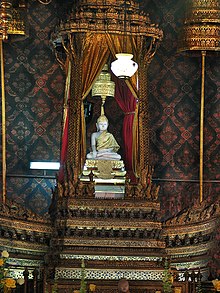Wat Thepthidaram
The Wat Thepthidaram ( Thai วัด เทพธิดา ราม , Temple of the Angel's Daughter , full name: Wat Thepthidaram Woraviharn - วัด เทพธิดา ราม วรวิหาร ) is a Buddhist temple complex ( Wat ) in the inner area of the Rattanakosin Island in Bangkok . The complex was built between 1836 and 1839 by King Rama III. built in honor of his oldest favorite daughter Vilas (full name: Krommamuen Apsorn Sudathep , กรม หมื่น อัปสร สุดา เทพ ). Wat Thepthidaram is a third class royal temple .
location
The temple is located in the Phra Nakhon district , on the eastern edge of the historic Rattanakosin Island. It is located directly south of Wat Ratchanatdaram and southwest of Wat Saket , whose "Golden Mountain" (Phu Khao Thong) is visible from afar. In front of the temple, Mahachai Road leads directly past the remains of the old city wall.
history
Although King Rama III. had already restored several temples in Bangkok, Wat Thepthidaram was the first new building in his reign. Construction in what was then Suan Lauang Phraya Krai ( สวนหลวง พระยา ไกร ) at the Samran Council Gate ( ประตู สำราญราษฎร์ ) was supervised by the construction manager, Prince Laddawan. This place was remarkable in that at that time it was a transport center for the eastern Rattanakosin Island: directly to the north ran a connecting channel ( Khlong ) , which is now called Khlong Wat Thepthidaram. It connects the inner city fortification canal, the Khlong Lord, with the Khlong Robb Krung (literally: "Canal that surrounds the whole city"). Via the Khlong Maha Nak ( คลอง มหานาค ) there was a direct connection from the royal palace to the eastern parts of Siam . When the temple was completed in 1893, the king personally tied the ceremonial ribbon around the temple during the opening ceremony and officially granted land rights to it.
architecture
According to tradition, the temple area is strictly separated into two areas, the western half is occupied by the Sanghawat , the living area of the monks. The eastern half is called Putthawat , here are the buildings dedicated to the Buddha, the Ubosot , a Viharn and a Sala Kan Parian (study hall ). Each building is strictly west-east oriented and is surrounded by its own wall ( Kampheng Kaeo ) , "crowned" gates provide access between the individual buildings.
The Chinese-influenced architectural style preferred by the king at that time even got its own name: Silpa Phra Ratscha Niyom ( ศิลปะ พระ ราช นิยม - “the art preferred by the king”).
- The ubosot shows the characteristic Thai-Chinese architectural style of that period, the gables are decorated with Chinese porcelain. At the four corner points of the forecourt around the ubosot are medium-high prangs , the bases of which are surrounded by small arcades. The main Buddha statue inside the Ubosot is the statue Luang Phor Khao ( หลวง พ่อ ขาว , not to be confused with numerous other statues of the same name, also: Phra Puttha Devavilasa ) made of white marble in the Chiang Saen style. Measured over both knees, it is 14 Niu (Thai: นิ้ว ) wide and 20 Niu high - the equivalent of 28 cm wide and 40 cm high ( see also: Old dimensions and weights ).
- The viharn is built in a similar style to the ubosot, with 14 chedis in the forecourt at regular intervals. Inside there are 43 statues of kneeling bhikkhunis which were cast from Nak, a typical Thai tin-copper alloy.
More Attractions
Many stone sculptures are placed within the temple area. They are made in a unique Chinese style, they were brought from China as ballast of the old merchant ships.
The kutis in the living area of the monks were also built by artists from the Rama III period. Every building is unique. Wat Theptidaram is known through the long stay of the Thai national poet Sunthorn Phu , who lived here as a monk between 1839 and 1842. His kuti has now become a museum.
More recently, the monastery and its abbot Phra Ratworamithi have tried to revive the classical Thai pi-phat music and the religiously motivated temple music Siang Phat and bring them to regular performance.
Web links
Coordinates: 13 ° 45 ′ 12 ″ N , 100 ° 30 ′ 16 ″ E


